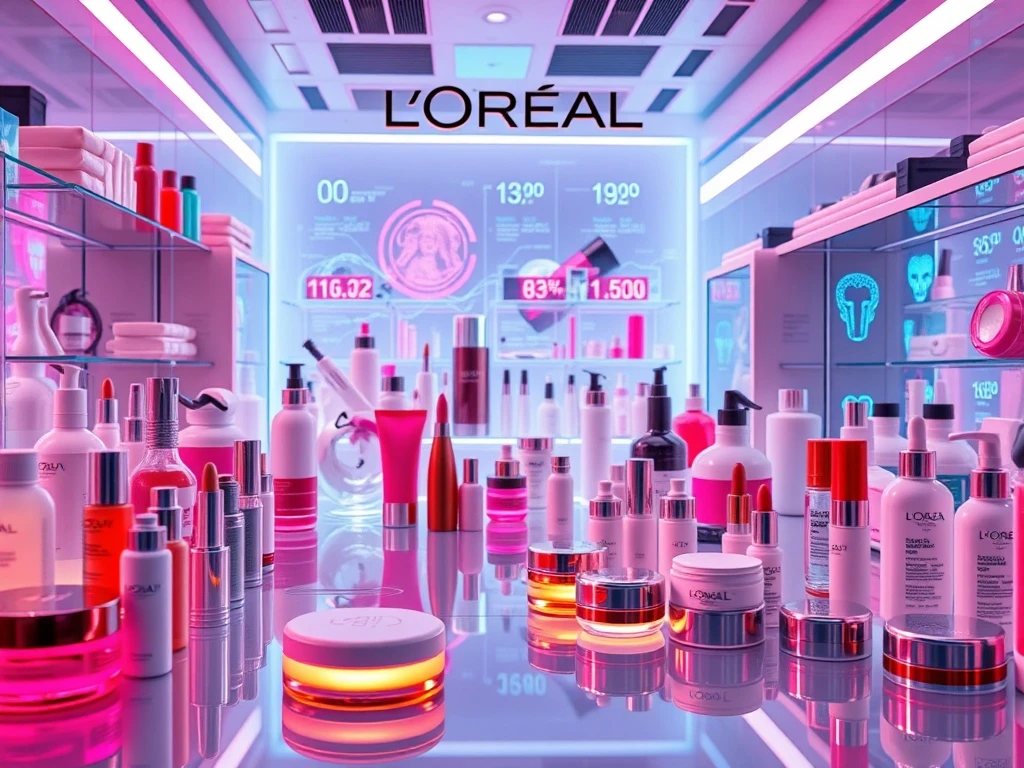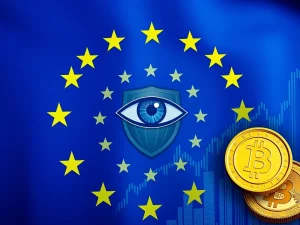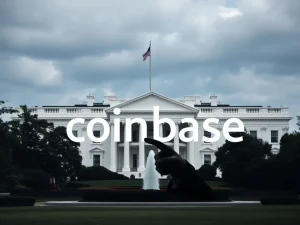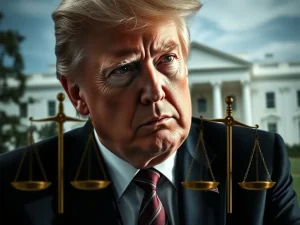Unstoppable L’Oréal: How Strategic Acquisitions & Innovation Propelled Astounding 12.3% Growth

In the dynamic world of cryptocurrencies, adaptability and foresight are paramount. But what can we learn from a traditional titan like L’Oréal, a company that has not only survived but thrived, achieving significant L’Oréal growth in a rapidly evolving market? Their journey offers invaluable lessons on navigating disruption, leveraging technology, and executing strategic moves that resonate far beyond the beauty sector. While the crypto space grapples with its own unique challenges, L’Oréal’s blueprint for success—rooted in relentless innovation and calculated expansion—provides a compelling case study for any entity aiming for long-term dominance.
L’Oréal’s Unprecedented Growth Trajectory: A Decade of Dominance
L’Oréal has consistently defied the odds, maintaining its global leadership in the beauty market despite intense competition from agile, digital-native brands and celebrity-backed ventures. Since 2014, the French cosmetics giant has achieved nearly double its $47 billion turnover, showcasing a robust and sustained period of expansion. This impressive L’Oréal growth trajectory is a testament to its multifaceted strategy, which expertly balances tradition with forward-thinking initiatives.
- Market Outperformance: L’Oréal has consistently outpaced rivals like Estée Lauder, solidifying its position at the forefront of the $450 billion beauty industry.
- Strategic Adaptation: The company’s success stems from its ability to adapt to shifting consumer demands while meticulously preserving the distinct identities of its 37 diverse brands, which span mass-market, prestige, and dermatological skincare categories.
- Global Reach: Geographic diversification has been a key driver, with like-for-like sales soaring by 12.3% in Africa and Asia (excluding China, Japan, and Korea) in 2024, demonstrating its capacity to tap into emerging markets.
Pioneering Beauty Market Innovation: The Core of L’Oréal’s Strategy
At the heart of L’Oréal’s enduring success is an unwavering commitment to beauty market innovation. Deputy CEO Barbara Lavernos emphasizes that innovation isn’t just a department; it’s the very foundation of their strategy. The company’s investment in research and development is staggering, reflecting a belief that scientific advancement is the ultimate differentiator.
In 2024 alone, L’Oréal invested a remarkable €1.3 billion in research and innovation, a figure that surpasses the combined budgets of its three largest competitors. This substantial investment fuels a relentless pursuit of hard science and cutting-edge, AI-driven technologies. Examples of this pioneering spirit include:
- BETiq System: An AI-powered system designed to optimize marketing spend, yielding a significant 10–15% improvement in Return on Investment (ROI).
- Digital Twins: Utilizing 14.5-terabyte datasets to create digital twins for complex hair types, such as curly and Afro-textured hair. This accelerates product development by allowing for virtual testing and formulation adjustments.
- New Formulas: These dedicated efforts resulted in the launch of 3,636 new formulas in 2024 alone, demonstrating the tangible output of their innovation engine.
L’Oréal’s focus on science and technology is deeply rooted in its 116-year history, supported by a global network of 4,200 researchers. Their work extends to ethical testing, including the groundbreaking development of reconstructed human skin.
The Power of Strategic Acquisitions: Fueling Growth and Diversity
A significant component of L’Oréal’s remarkable expansion and sustained L’Oréal growth has been its astute approach to strategic acquisitions. Since 2014, the company has skillfully integrated a range of brands that align with emerging market trends, while crucially allowing them to retain their unique identities.
Key acquisitions include:
- NYX Professional Makeup: Tapping into the vibrant, digitally-native makeup artistry segment.
- CeraVe: Expanding its dermatological skincare portfolio, a category with increasing consumer demand for science-backed solutions.
- Dr. G: Providing a gateway into the booming Korean beauty market, a global trendsetter.
- Medik8 (2024 majority acquisition): Highlighting collaborative R&D opportunities in the high-performance skincare segment.
Analysts commend L’Oréal’s ability to leverage its extensive global supply chain and marketing expertise to scale these smaller brands. This symbiotic relationship allows acquired companies to flourish under L’Oréal’s umbrella without being subsumed. Furthermore, L’Oréal’s strategic licensing deals with luxury fashion houses like Prada and Armani have significantly amplified its reach, contributing to the Luxe division’s global leadership in prestige beauty.
Navigating Cosmetics Industry Trends with Diversification
L’Oréal’s robust and diverse portfolio acts as a critical buffer against market volatility and shifting cosmetics industry trends. By maintaining a strong presence across mass-market, prestige, and dermatological segments, the company can mitigate risks from specific downturns, such as slower growth for global brands in China.
- Risk Mitigation: When mass-market sales experience a dip, prestige customers often trade down, providing a built-in stability mechanism. Conversely, the strength of the luxury segment provides consistent high-margin revenue.
- Trend Identification: Analyst Fon Udomsilpa highlights L’Oréal’s exceptional ability to identify and capitalize on emerging trends, citing its leadership in the face mask category, which originated from Korean beauty.
- Geographic Expansion: Beyond established markets, L’Oréal actively pursues growth in high-potential regions, as evidenced by its strong sales performance in Africa and parts of Asia.
This strategic diversification ensures that L’Oréal remains resilient and adaptable, positioning itself to capitalize on opportunities across the entire beauty spectrum.
How AI in Beauty is Redefining Product Development and Marketing
The integration of AI in beauty is not just a buzzword for L’Oréal; it’s a fundamental pillar of their future strategy. The company is leveraging artificial intelligence to revolutionize everything from product development to marketing effectiveness, showcasing a forward-thinking approach that sets them apart.
As discussed, the BETiq system exemplifies AI’s direct impact on business operations, optimizing marketing spend and significantly boosting ROI. Beyond marketing, AI is transforming the very science of beauty:
- Accelerated R&D: The use of massive datasets to create digital twins for hair textures dramatically speeds up the product development cycle, allowing researchers to experiment and refine formulas virtually before costly physical trials.
- Personalization Potential: While not explicitly detailed in the provided content, the extensive data collection and AI analysis capabilities lay the groundwork for highly personalized beauty solutions, a key future trend in the industry.
- Predictive Analytics: AI enables L’Oréal to better predict consumer preferences and market shifts, allowing for proactive product launches and strategic positioning.
This commitment to AI ensures that L’Oréal not only keeps pace with technological advancements but actively drives them within the beauty sector, creating a competitive advantage that is difficult for rivals to replicate.
A Vision for the Long Term: The Strength of Ownership and Culture
Underpinning L’Oréal’s remarkable resilience and consistent L’Oréal growth is its unique ownership structure and deeply ingrained long-term vision. The company is majority-owned by the Bettencourt Meyers family and Nestlé. This arrangement, described by Barbara Lavernos as “the best of both worlds,” combines the agility and strategic focus often found in family governance with the discipline and transparency of public markets.
This structure enables sustained, substantial investment in critical areas like R&D and Mergers & Acquisitions (M&A) without the short-term pressures often faced by purely public companies. CEO Nicolas Hieronimus fosters a culture of “healthy concern,” ensuring the company remains vigilant and proactive in anticipating and responding to disruptive innovations.
Navigating Challenges and Embracing a “Confrontational Spirit”
Despite its formidable position, L’Oréal is not immune to challenges, such as shifts in the U.S. mass-market makeup segment and evolving consumer demographics, particularly Gen Z. However, the company approaches these obstacles with confidence and a proactive mindset.
Its 2024 “beauty stimulus” plan includes intensified product launches specifically targeting younger demographics and social media users, recognizing the importance of digital engagement. Lavernos attributes the company’s enduring success to its “confrontational spirit,” where internal competition and external market pressures are viewed as catalysts for continuous innovation and improvement. By remaining agile, strategically investing, and prioritizing long-term value creation, L’Oréal aims to solidify its leadership in a rapidly transforming industry for years to come.
Conclusion: L’Oréal’s Blueprint for Enduring Success
L’Oréal’s journey since 2014 offers a compelling masterclass in sustainable business growth. Their impressive L’Oréal growth, driven by an unwavering commitment to beauty market innovation, shrewd strategic acquisitions, and a deep understanding of evolving cosmetics industry trends, provides a powerful blueprint. The proactive adoption of advanced technologies like AI in beauty, coupled with a long-term vision fostered by its unique ownership structure, demonstrates how a legacy brand can not only adapt but thrive amidst disruption. For any business, including those in the nascent crypto space, L’Oréal’s story underscores the vital importance of adaptability, continuous investment in R&D, and the courage to embrace change as an opportunity for unparalleled expansion.
Frequently Asked Questions (FAQs)
Q1: How has L’Oréal maintained its market dominance over the past decade?
L’Oréal has maintained dominance through strategic acquisitions, heavy investment in research and innovation (including AI-driven technologies), and a long-term ownership structure that allows for sustained investment without short-term pressures. They also excel at adapting to consumer demands while preserving brand identities.
Q2: What role does innovation play in L’Oréal’s growth strategy?
Innovation is central to L’Oréal’s strategy. They invested €1.3 billion in R&D in 2024, focusing on hard science and AI-driven technologies like BETiq for marketing optimization and digital twins for product development. This commitment results in thousands of new formulas launched annually.
Q3: Which key acquisitions have contributed to L’Oréal’s success?
Since 2014, key acquisitions include NYX, CeraVe, Dr. G, and Medik8. These strategic moves allowed L’Oréal to tap into emerging trends (like Korean beauty) and expand its portfolio while leveraging its global supply chain and marketing expertise to help the acquired brands scale.
Q4: How does L’Oréal mitigate risks from market downturns or changing trends?
L’Oréal mitigates risks through a diverse portfolio spanning mass-market, prestige, and dermatological categories, ensuring stability even if one segment dips. Geographic diversification, with strong growth in regions like Africa and Asia, also insulates them from market-specific slowdowns.
Q5: What is the significance of AI in L’Oréal’s beauty operations?
AI is significant in optimizing marketing spend (e.g., BETiq system improving ROI by 10-15%) and accelerating product development. Examples include using 14.5-terabyte datasets to create digital twins for hair, allowing for faster and more efficient formula creation and testing.








